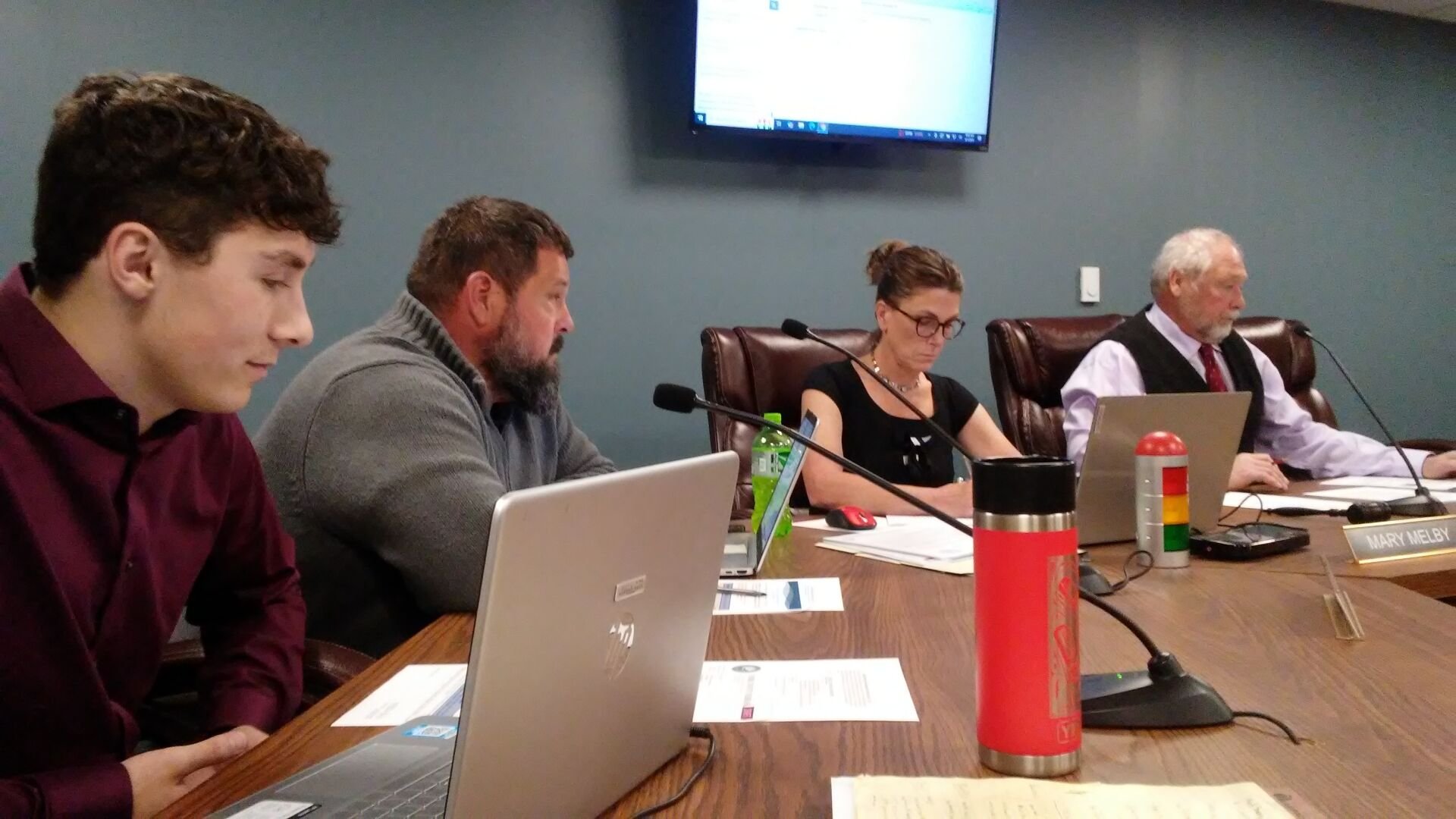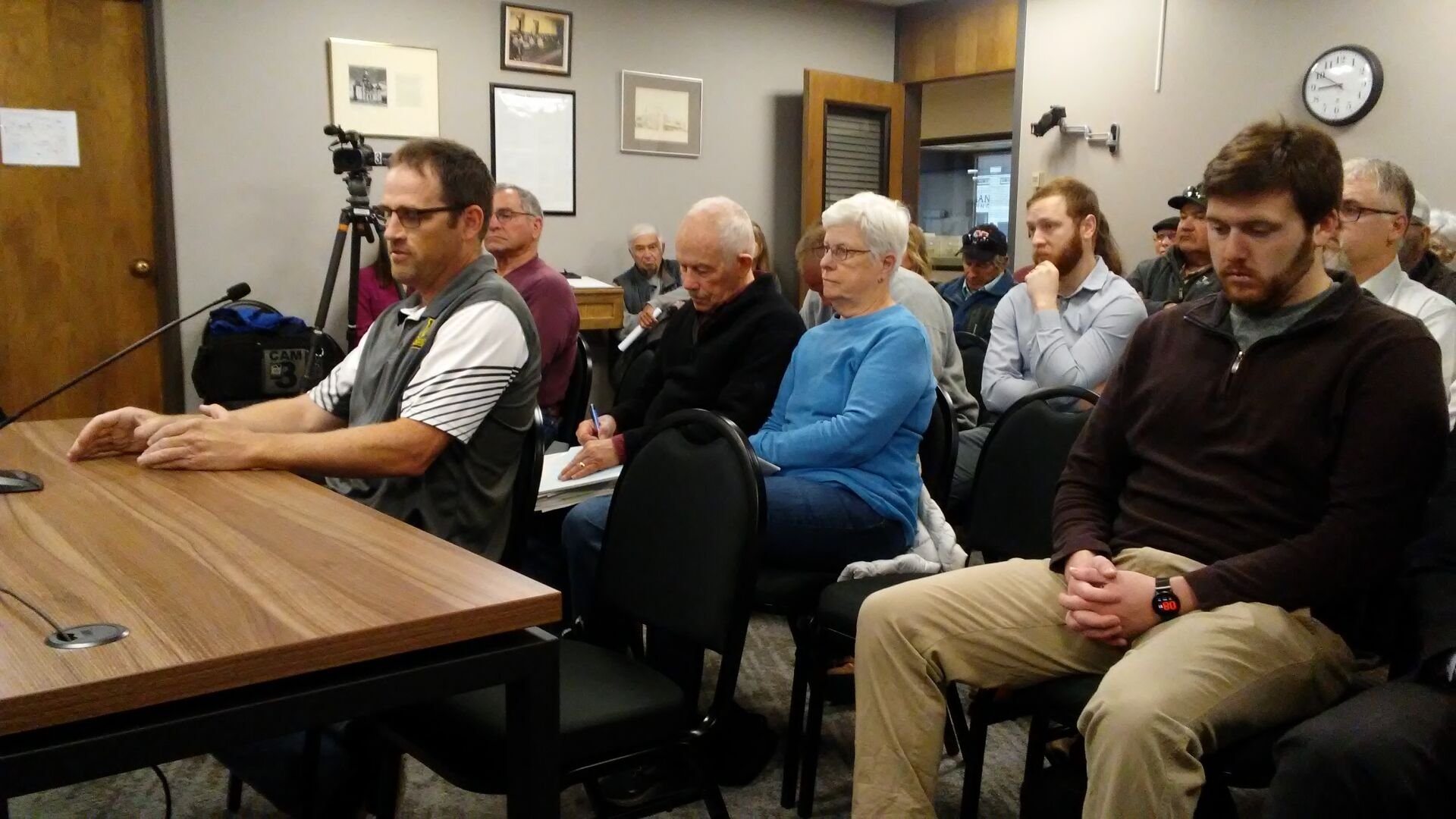York News-Times reprint
Written by RJ Post / R.J. POST, YORK NEWS-TIMES
It took a gray, cloudy day and nearly three years of discussion, debate and public meetings, but York County finally has solar zoning regulations.
The York County Board of Commissioners voted 3-2 on Tuesday to approve the regulations as sent back to them by the county’s Planning and Zoning Board. County Board Chairman Randy Obermier and Commissioner Joe Burgess voted no.
The packed boardroom erupted into applause after the regulations passed.
“I feel like we need to have some form of zoning for solar,” Obermier said. “I do disagree with the way that it’s presented now.”
He called some of the setbacks included in the regulations “not reasonable” and “project killers.”

York County Commissioners Joe Burgess, Andy Bowman, and Randy Obermier (from left) discuss proposed solar zoning regulations Tuesday at the York County Courthouse as County Clerk Mary Melby takes notes – photo R.J. Post.
Commissioner Daniel Grotz, however, pointed to the county’s existing comprehensive plan.
“York County should continue to be dominated by agriculture production, specifically crop and livestock production,” Grotz quoted from the plan. “Loss of prime land, cropland, to non-cropland usage should be avoided as much as possible.”
Grotz addressed the issue of setbacks, which has been the crux of much of the debate over the solar regulations.
“To minimize impacts on neighboring uses, particularly residential uses, adequate separation distances are required,” he quoted again from the comprehensive plan. “It’s known that we should have some sort of setback.”
Four classes
The zoning regulations approved on Tuesday establish four classes of solar facilities increasing in size.
Setbacks vary from 75 feet for Class 1 to half a mile for Class 4.
Grotz said the comprehensive plan states that commercial or industrial uses should be encouraged to find locations in or near municipalities. But he acknowledged that, with solar arrays possibly being half as large as the City of York, that would be difficult to accomplish.
“In our comp plan, it’s very well stated that rural York County is traditional agriculture,” he said. People who move to the country expect to live in the country.
“There was a reasonable expectation that that’s what they would see,” Grotz said. “We have to come up with something where we’re not greatly changing that expectation.”

Grant Jackson of McCool Junction makes the point that setbacks should be greater for bigger solar facilities during the public comment session of Tuesday’s York County board meeting. He was one of eight county residents who spoke on the issue – photo R.J. Post
“I would completely agree with Daniel on what our comp plan says,” Commissioner Andy Bowman said. “When people do buy acreages, they’re buying acreages to live in the country, not next to an industrial compound of any sort.
“We’re an agricultural county. That is our bread and butter,” Bowman said. “Farm ground in York County needs to stay farm ground.”
He made the motion to approve the solar regulations as set forth by the zoning board.
The zoning board first sent the proposed rules to county commissioners in January 2024. The commissioners made some revisions and sent them back to the zoning board. On Feb. 24, that board voted to return the regulations to the county commissioners.
Commissioner LeRoy Ott seconded the motion so the commissioners could continue discussion before voting.
For his part, Burgess raised a number of objections to the regulations as written, including proposing a number of grammatical changes.
But he added, “I think the current setbacks as we have them are unreasonable.”
He pointed to the difference in setbacks for Class 3 and Class 4. Class 3 covers commercial installations of 1 to 5 megawatts and carries setbacks of 75 feet from a non-participating property and 330 feet from a non-participating dwelling.
Setbacks for Class 4 — a commercial installation of more than 5 megawatts — are 660 feet from a non-participating property and 2,640 feet, or half a mile, from a non-participating dwelling.
“I would actually like to get rid of Class 4 in general and consolidate that with Class 3,” Burgess said. “Whether that means we need to change the Class 3 setbacks or make some sort of compromise on that, that is completely fine.
“I don’t think there’s a good reason why Class 4 needs to be so much larger than Class 3,” he said. “It’s the same type of equipment. It’s just over more area.”
Conditional use permits
Obermier pointed out that, regardless of how they voted on Tuesday, projects will still come before the commissioners for conditional use permits that they can reject if they have good cause.
“My feelings haven’t changed as far as the setbacks,” he said. “I think that setbacks like these are a project killer.
“I just believe that that’s the way these were set up,” Obermier added. “They’re not reasonable zoning that we could put forward.”
Ott predicted the board would not reach consensus on the solar zoning.
“You’re going to get a vote that might be 3-2 or 4-1,” he said.
“I’ve been trying to find a spot between OPPD and the people who live out there,” Ott said, referring to Omaha Public Power District, which wants to build a solar project near McCool Junction. “There is no middle space.”
He would have to err on the side of caution, he said.
In other action on Tuesday, the commissioners:
- Rejected on a 2-3 vote an application for a $1,000 York County Visitors Bureau Improvement Grant to help pay for the colored outdoor lights already in place at the York City Auditorium.
- Approved a letter of support for businesses wanting to do broadband projects in rural parts of the county.
- Authorized the chairman to sign State of Emergency Declarations for 2025 and ratified a declaration made by Obermier after the the March 19 blizzard.


































